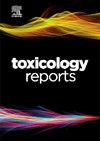Integrated logistic sigmoid model and graphical analyses of concentration-response relationships of copper sulfate toxicity in aquatic organisms
Q1 Environmental Science
引用次数: 0
Abstract
The logistic sigmoid model (LSM) of concentration-response relationships (CRRs) of copper sulfate in aquatic organisms encounters three problems, which are diverse types of toxicities, wide ranges of effect concentrations, and various patterns of graphical CRRs. These problems have caused difficulties in evaluating patterns of toxicities from abundant studies, comparing toxicities among various concentration levels, and drawing interpretations from numerous graphical analyses. A study addressing the problems and difficulties is urgently needed to increase the understanding of copper sulfate toxicity and its application in risk assessment and aquaculture. The aquatic organisms used in the present study consisted of fish (Cypriniformes, Cichliformes, and Salmoniformes) and invertebrate parasites (Amyloodinium spp., Icthyobodo spp., and Anacanthorus spp.). In this study, 10 LSM-based effect selection criteria were developed and used, a set of low-medium-high (LMH) and sigmoid-flat-quadrant (SFQ) graphs were created to evaluate a set of sublethal and lethal CRRs, and the usefulness of LSM-LMH-SFQ in aquatic toxicology was discussed. The 10 selection criteria included three concentration types, two slopes, three coefficients of variation, and two data fitness to the model requirements. Out of nine sublethal effects, three selected ones were chosen based on the 10 criteria. Likewise, three selected lethal effects out of seven were chosen. The SFQ graph identified a highly selected sublethal effect (Thiobarbituric Acid Reactive Substances, TBARS) and a highly lethal effect (LC50 of fry), based on ∆ log C (differences between concentrations) ≤ 1 µg. L−1 log scale and k (slope of CRR) ≥ 6. Lastly, the LSM-LMH-SFQ discussion emphasized its significance to applicability in sublethal-lethal and fish-parasite comparability and risk assessment of copper sulfate in aquatic animals.
水生生物硫酸铜毒性浓度-反应关系的综合logistic s型模型及图形分析
硫酸铜在水生生物体内的浓度-反应关系的logistic s型模型(LSM)面临着毒性类型多样、效应浓度范围广、浓度-反应关系图形模式多样的问题。这些问题给从大量研究中评估毒性模式、比较不同浓度水平的毒性以及从大量图形分析中得出解释造成了困难。为了提高对硫酸铜毒性及其在风险评估和水产养殖中的应用的认识,迫切需要解决这些问题和困难的研究。本研究使用的水生生物包括鱼类(鲤形目、鱼形目和鲑形目)和无脊椎寄生虫(Amyloodinium spp.、Icthyobodo spp.和Anacanthorus spp.)。本研究制定并应用了10个基于lsm的效应选择标准,建立了一组低-中-高(LMH)和s型平面象限(SFQ)图来评估一组亚致死和致死crr,并讨论了LSM-LMH-SFQ在水生毒理学中的应用价值。10个选择标准包括三种浓度类型、两种斜率、三种变异系数和两种数据适合模型要求。在9种亚致死效应中,根据10项标准选出了3种。同样,7种致命效应中有3种被选中。SFQ图确定了高度选择的亚致死效应(硫代巴比妥酸反应物质,TBARS)和高度致死效应(鱼种LC50),基于∆log C(浓度差异)≤ 1 µg。L−1对数尺度且k (CRR斜率)≥ 最后,LSM-LMH-SFQ讨论强调了其在水生动物硫酸铜亚致死-致死、鱼-寄生虫可比性和风险评估方面的适用性。
本文章由计算机程序翻译,如有差异,请以英文原文为准。
求助全文
约1分钟内获得全文
求助全文
来源期刊

Toxicology Reports
Environmental Science-Health, Toxicology and Mutagenesis
CiteScore
7.60
自引率
0.00%
发文量
228
审稿时长
11 weeks
 求助内容:
求助内容: 应助结果提醒方式:
应助结果提醒方式:


